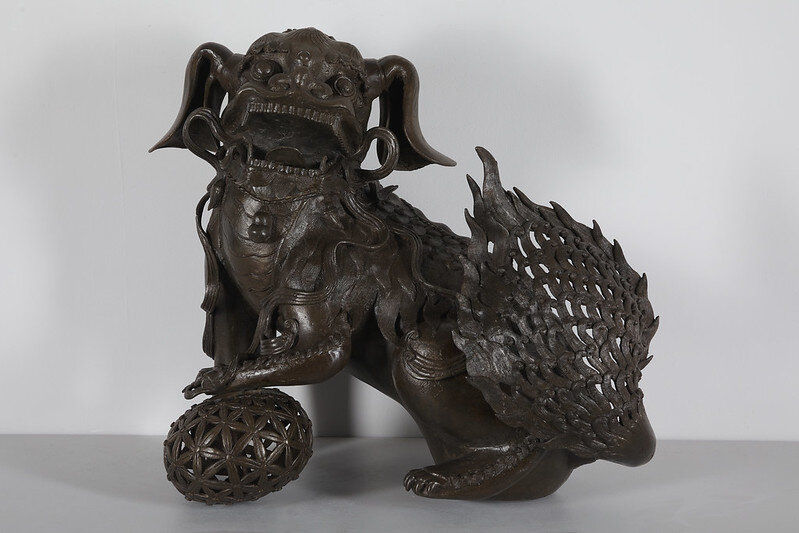Chinese Buddhistic Lions are symbols of feng shui that were traditionally placed in front of Imperial palaces and temples. Also called Imperial Guardian Lions, they can be a special addition to any private collection. They are usually bought and displayed in pairs—one male and one female. The male lion is identified by a globe under its paw, and the female likewise has a cub. These sculptures were thought to be protective from harmful spiritual influences and people, and were quickly adopted in many other Asian cultures. Embodying the principles of yin and yang, Buddhistic Lions were typically made of stone or metal and reserved for elite families or government buildings.
Female Before Treatment
Male Before Treatment
Cub Before Treatment
A pair of bronze Buddhistic Lions recently arrived at The Center for treatment after the client independently hired appraiser Gary Piattoni for an evaluation. In his opinion, the sculptures date to the 17th century.
The female lion evidenced excessive and poorly applied filler throughout the sculpture, placed originally to cover surface corrosion. The tail was broken at the base, along with pieces of the proper right ear. Our conservators also discovered a patch repair on the lower abdomen filled with lead.
Female Before Treatment Detail
Female Before Treatment Detail
Male Before Treatment Detail
Male Before Treatment Detail
Female Detached Tail
Male Detached Tail
Like its counterpart, the male lion also revealed evidence of poor repair work. There was excessive filler, and a large portion of the right ear was broken. Both sculptures were heavily coated in particulates and a moderate corrosion layer. Their surfaces were pitted and damaged, yet still retained most of their patina.
Josh McCauley, Senior Conservator of Frames and Gilded Objects, Steam Cleaning the Male Lion
The first step in conserving the sculptures was to remove the poorly applied fill material, excluding areas that were functioning as structural repairs. The existing fills, made of lead, were scraped and sculpted to match the existing carving on the surface of the sculptures, then sealed with a reversible acrylic resin to prevent oxidation.
The corrosion layers were removed with bronze phosphorus brushes and bronze wool, and the stubborn areas of corrosion were selectively removed with a gel solution without disturbing the patina. Next, the sculptures were steam cleaned with deionized water. Deionized water is free of mineral, deposits, and ionic charge, all of which are found in regular tap water and can react with metal surfaces.
Repairing the Base
Structural Netting Added
Fill Added and Ready for Pigment
The damaged ear was filled and repaired before reattachment with pins and epoxy. The tails are connected with a wedge-shaped joint that had areas of structural damage. They were similarly reattached and strengthened using the appropriate conservation methods and materials. Large areas of loss were filled with bulked epoxy and sculpted to match surroundings, and minor losses were filled with a conservation-grade, acrylic-based paste.
Female During Treatment
Male During Treatment
Sculpting Repaired Areas of Loss
Repaired Areas of Loss Detail
Mixing Reversible Acrylic Resin and Pigment
Different Shades of Reversible Acrylic Resin and Pigment for Mixing
Inpainting Repaired Areas
Inpainting Progress
The repairs were then inpainted with an acrylic resin mixed with ground pigments to match the surrounding surface. A stainless-steel pin was added to the female lion at the connection point between her paw and the cub beneath to repair the break of the original pin and keep the sculpture stable.
During Treatment
Stainless-Steel Pin to Connect Female with Cub
Scrubbing the Surface with Waxing Brush
A thin layer of clear wax was applied to the entire surface for saturation and protection. We hope that the Buddhistic Lions will now bring even more feng shui to their home!
Female Before Treatment
Female After Treatment
Male Before Treatment
Male After Treatment
Female After Treatment Detail
Cub After Treatment Detail































